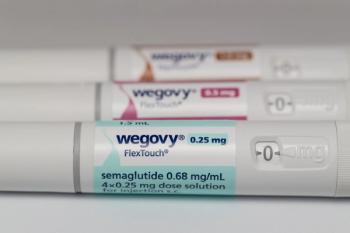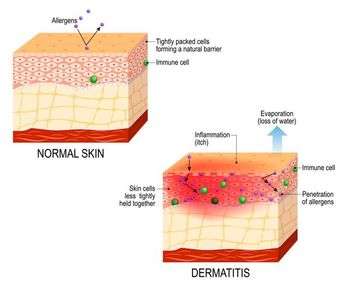
Erenumab Rx Early in Episodic Migraine Found Superior to Oral Prophylactic Agents for Efficacy, Tolerability, Adherence
The phase 4 APPRAISE trial found greater efficacy with erenumab after failure with 1 or 2 other preventives vs ongoing treatment with the nonspecific oral agents.
Recently published data from the phase 4 APPRIASE study (NCT03927144) showed that earlier use of erenumab (Aimovig; Amgen) in patients with episodic migraine (EM) who failed 1 or 2 preventive treatments resulted in better long-term efficacy, tolerability, and adherence than use of oral prophylactics.
Overall, patients treated with the calcitonin gene-related peptide (CGRP) medication were 6 times more likely to achieve 50% or greater reduction in monthly migraine days, further stressing the significance of early initiation of treatment.
The pragmatic study spanning across 17 countries randomized 621 eligible participants with EM 2:1 to either erenumab (n = 413) or nonspecific oral migraine preventive medications (OMPMs; n = 208) for a 12-month period. OMPMs, which include ß-blockers, calcium channel blockers, antiepileptics, and antidepressants, have been a standard of care for migraine prevention; however, OMPMs were not specifically developed for migraine, and most of them have insufficient or limited evidence of efficacy or safety.
Led by Patricia Pozo-Rosich, MD, PhD, director of the Headache and Craniofacial Pain Clinical Unit and the Migraine Adaptive Brain Center at the Vall d’Hebron University Hospital, 532 patients (84.2%) completed the treatment phase and 98 (15.8%) discontinued the study. After 12 months of treatment, the primary end point, achievement of a reduction of 50% or greater in monthly migraine days (MMDs), was achieved by 86.9% of those initially assigned erenumab treatment vs 37.5% of those in the OMPM arm (OR, 11.27; 95% CI, 7.53-16.87; P <.001). Erenumab continued to outperform OMPMs on the primary end point regardless of whether patients switched treatment from week 12 through week 52.
"Earlier initiation of erenumab may ultimately lead to fewer patients discontinuing or switching medication in a real-world clinical practice," the study authors concluded. "Moreover, these findings may help reduce health care resource utilization, decrease disability, and increase better quality of life. These findings lend further support to the recent guideline update issued by the European Headache Federation, in which CGRP-targeted mAbs are considered as a first-line treatment option for patients with migraine who require preventive treatment."
APPRAISE is unique in that it tested erenumab in patients with EM who failed 1-2 previous migraine preventive treatments when traditionally access to CGRP-targeted monoclonal antibodies is often limited to those with 3 to 5 previous preventive failures. The study also encompassed a practical methodology, granting physicians the autonomy to determine the treatment trajectory after randomization, in both treatment arms and within local protocols, mirroring real-world clinical practice.
Overall, 13% (n = 81) of the cohort switched from their initially assigned treatment. Among patients who switched 8 of 9 (88.9%; erenumab) and 31 of 72 (43.1%; OMPMs) reported a lack of efficacy, whereas 1 of 9 (11.1; erenumab) and 36 of 72 (50.0%; OMPMs) reported a lack of tolerability as the primary reason. At month 12, using the complete cohort, the change in adjusted mean MMDs was –4.32 days for erenumab and –2.65 days for OMPMs (treatment difference, –1.67 [SE, 0.35] days; P <.001).
In terms of safety, treatment-emergent adverse events (TEAEs) were recorded in 74.8% of those on erenumab and 76.2% of those on OMPMs; however, after adjusting for exposure to treatment, the exposure-adjusted rate was approximately 30% lower in those treated treated with the CGRP monoclonal antibody. Erenumab-treated patients had less AEs suspected to be related to the study drug (32.1% vs 56.3%), and mostly comprised constipation (12.3%) and injection site pain (4.7%). For OMPMs, the most related AEs were fatigue (14.1%) and weight increase (9.7%).
Between the 2 groups, the incidence of AEs leading to treatment discontinuation was approximately 8 times lower in patients treated with erenumeb (2.9% initially dosed) vs OMPMs (23.3%, including 9 others who switched from erenumab arm). Furthermore, the incidence of AEs leading to dose adjustment was approximately 15 times lower in the erenumab arm (1.0%; n = 4) than the OMPM arm (15.5%; n = 32). Of note, constipation was more frequently observed in the erenumab group compared with OMPMs (13.0% vs 1.0%). One patient on the CGRP medication reported severe constipation, which resolved after treatment with a laxative.
At 12 months, 76.0% of those on erenumab and 18.8% of those on OMPMs were identified as responders on the PGIC scale (OR, 13.75; 95% CI, 9.08-20.83; P <.001). Of patients who switched treatment, 24.7% (20 of 81) were identified as responders at month 12. In the OMPM arm, most patients were initially given ß-blockers (31.3%), topiramate (Topamax; 22.1%), and tricyclic antidepressants (15.9%).
REFERENCE
1. Pozo-Rosich P, Dolezil D, Paemeleire K, et al. Early use of erenumab vs nonspecific oral migraine preventives: the APPRAISE randomized clinical trial. JAMA Neurol. Published online March 25, 2024. doi:10.1001/jamaneurol.2024.0368
Newsletter
Enhance your clinical practice with the Patient Care newsletter, offering the latest evidence-based guidelines, diagnostic insights, and treatment strategies for primary care physicians.

































































































































































































































































































